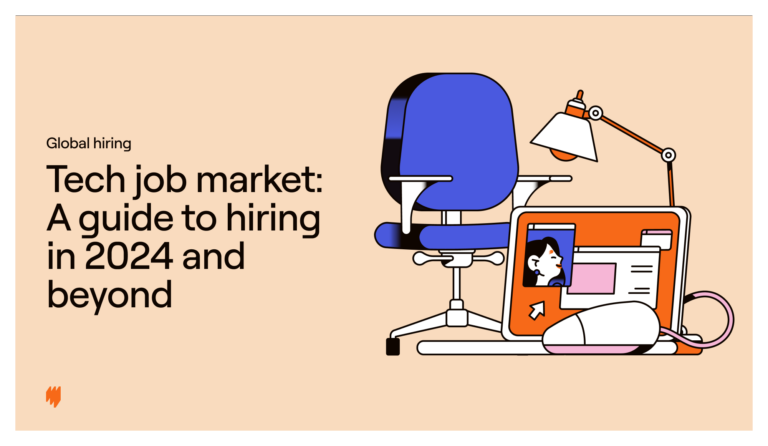In 2024, 75% of businesses across the world are reporting difficulty finding the skilled talent they need. And, with technological advancements widening the gap between employee capabilities and industry demands, this problem only looks set to worsen.
As Matt Charney, Editor in Chief at Recruiter.com, puts it: “A growing set of companies are competing for a finite set of skills that sometimes don’t even exist in the first place.”
This article will break down the driving factors behind the talent gap and provide practical solutions to help your business hire and retain the skills needed to stay competitive.
What’s behind the talent gap?
Across sectors, companies are battling with the same issue — there aren’t enough workers with the skills they need to keep up with the rapidly changing demands of their industry. This is symptomatic of a wider problem, the talent crunch, which details the fact that there is an increasingly small pool of skilled individuals to hire from.
Here are the main issues that have led us to this point:
- Skills gaps: Over 375 million people will be required to learn new skills to meet workplace demands in the coming years. This is largely due to the rise of AI which means companies need employees to be able to work alongside new technology.
- An aging workforce: Older workers, who are often reluctant to be trained in new skills, will make up a quarter of the workforce by 2031.
- Increased retirement: Each day, about 10,000 people born between 1946 and 1964 leave the U.S. workforce. We are also still feeling the impact of the COVID-19 pandemic which accelerated retirement rates.
- A decline in workforce activity: As well as working fewer hours, more people are ditching full-time work altogether. In fact, workplace activity in the US has been steadily declining by 3% since the beginning of the century.
A closer look at the consequences of skills shortages
Beyond the obvious struggle of lacking skills, the talent gap has a profound impact on a company’s ability to innovate, compete, and grow. Here we look at how.
Wage inflation
With more and more competition for the same set of skills, wages rise. And, as Charney explains, this leaves organizations with a difficult choice. “You either pay more or settle for less talented and qualified workers.”
If you’re forced to hire inexperienced workers, this could have a knock-on effect on your team. “Companies quickly start seeing the effects of institutional knowledge gaps,” Charney describes.
Short-term thinking
“The talent gap leads companies to adopt a scarcity mindset,” Charney points out. Rather than focusing on the bigger picture, it can be easy to think, in his own words, “Where do we get this niche set of skills we need right now?!”
The focus should be longer-term; Charney recommends framing it like this: “Who can we hire that will help us prepare for however the future of the workplace will look?”
Retention issues
“When there aren’t enough skills to go around, companies start poaching employees more often,” Charney says. The result is that it’s not only hard to attract new workers with the skills you need but also to hold onto those you have.
Sector disparities
It’s worth noting that some sectors are disproportionately impacted by the talent gap than others. Those with higher numbers of older workers (such as accounting and construction, for example) will struggle unless they have enough new recruits coming in out of educational institutions. Often, however, they don’t as younger talent has less interest in these more traditional industries.
How to close the talent gap for good
Want to learn how companies are hiring in spite of the talent crunch? Read on.
Conduct talent gap analysis
Start with talent gap analysis. Ask yourself how well-equipped is your team to service your company’s goals now and into the future. Map out the abilities required for each role and those that exist in your team currently.
Be sure to take into account where AI could automate work and where you would like your employees to work alongside new software. “Automation and AI are going to eliminate jobs, but companies are doing employees a disservice by not proactively considering how they can fit in with this new world of work,” Charney describes.
Invest in training
As Charney says, “The talent gap could partly be solved if more companies were willing to offer internal training or subsidize initiatives.”
By aligning with educational institutions and vocational training programs, you can proactively address shortages by fostering a steady stream of skilled workers. Charney says. “Companies should make more use of the network of people who have had training, but don’t have degrees.”
Meanwhile, for internal training programs to be successful, balance your skills requirements against your employees’ own needs and career paths. As Charney says: “It’s crucial to assess who you have and look at their professional interests before creating a plan with a clear end in sight.”
Broaden your talent pool
“With a borderless workforce, you can hire from anywhere,” Charney explains, “This means you can find the exact skills you need rather than those that exist nearby.” By using an EOR such as Multiplier, you can hire new employees anywhere in the world without setting up a local entity. Our solution exists to democratize opportunities for both employers and employees.
Accessing global talent with Multiplier
Between staying compliant with complex local laws and managing payroll in several locations, global hiring can make you feel like you’re losing your mind. Multiplier takes the weight off your shoulders by handling the entire process of onboarding, paying, and managing your team wherever they are, in one place.
We manage global payroll, provide visa support, and distribute localized benefits so you can provide a great employee experience from day one.
As soon as you find the skills you need, we can send over a locally compliant contract in seconds. Ready to get started? Speak with one of our team.

Beth Longman
Content Writer
Beth Longman is a content writer at Multiplier. With extensive experience in SaaS, she combines data with storytelling to create engaging pieces.





